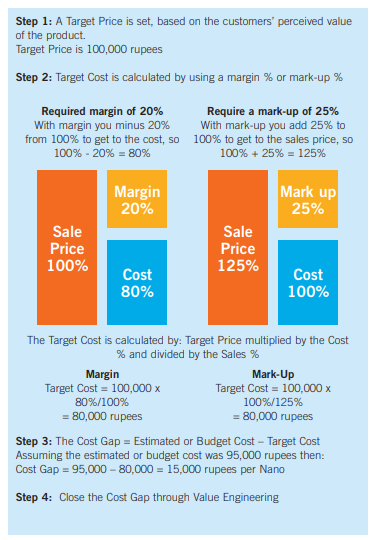
April 2021
Jo Tuffill offers a lesson in target costing and non-financial indicators.
The Tata Nano was a compact car manufactured by Tata Motors, primarily for the market in India. As an inexpensive hatchback it was intended to appeal to riders of motorcycles and scooters. It had the tantalizing launch price of ‘one lakh’ (100,000 rupees/$2,500). Owning a car was suddenly within the reach of more of India’s population.
This is a great example of target costing. The market price had to be ‘one lakh’ and so the cost of production had to come down to allow for a margin on a sale.
The cost of this no-frills car was brought down by dispensing with most non-essential features, reducing the amount of steel used in its construction, and relying on low-cost labour. Dispensing with the nonessential features is an example of focusing on what the customer values or removing non value-added features. This led to cost reductions, like the passenger’s side wing mirror, one wiper blade, having only three lug nuts per wheel, and the removal of the fuel filler cap from the tank.
The techniques used here are Value Engineering (design and development) and Value Analysis (audit of product and production). These techniques look at every aspect of design, production and product, with the objective to reduce costs whilst satisfying customer requirements.
Target Cost – a four-step process

Non-Financial Indicators – so what happened to the Nano?
At the launch in 2009 the Nano received 200,000 orders even before the first Nano had been produced. It was set to be revolutionary, India’s answer to Ford’s Model T and VW’s Beetle. Several international awards were bestowed on the tiny car for features such as fuel efficiency, low emission levels, adhering to all the regulations of the time and yet bundled at an affordable price.
It all started so well. Autocar’s Tata Nano review described the vehicle as “cheap and undeniably cheerful. Unbelievable value, if only you could buy one in the UK.”
They planned to sell 250,000 cars a year, however, the best annual sales level achieved was only around 75,000 cars, and in June 2018 just three Nanos were sold and production ceased.
The sad demise of the little Nano can be attributed to various reasons:
• Safety record: crash performance tests in Germany were given ‘zero stars’ and in Mumbai a Nano caught fire (with more to follow).
• Quality ratings: customers complained of poor ride comfort and stability issues due to its lightweight body. Some reported their Nano cars had basic functionality failures, like the starter motor, speedometer and horn.
• Customer perception: the stigma of buying the ‘cheapest car’ proved to be its undoing. It was considered a poor person’s vehicle. To avoid being associated with a ‘cheap car’ some Indian consumers were witnessed buying a used car from a higher segment rather than buying a new Nano.
• Market penetration: the dealer network was situated only in urban areas while the target market was situated in towns and villages. This made it difficult to market the Nano to their target market, who were not familiar with the car buying experience.
Non-financial indicators
The non-financial aspects indicated the car’s demise: safety, quality, customer perception and market penetration. In the PM exam you will be expected to appreciate that it is the non-financial drivers of performance that are critical and that it is these drivers that determine the financial results.
A lesson learned
The Tata Nano’s problems started right at the beginning with its target price. It seems that the ‘one lakh’ price tag was just too cheap for a car.
• Jo Tuffill is the PM Tutor with FME Learn Online. Please note that sources for this article came from publicly available information and have not been fact-checked.